A handmade dragon bonsai pottery isn’t just a container; it’s a story told through clay and fire, blending ancient symbolism with traditional living art bonsai pots.
The craft of making pottery intended for Bonsai trees originates from China, possibly dating back to the Song dynasty (11th century). The potting techniques spread to Japan centuries later, but even today, the most well-known and expensive Bonsai trees are held in antique Chinese containers.
Dragon bonsai pottery, particularly in Chinese and Japanese traditions, symbolizes power, wisdom, and longevity. The dragon is a revered mythical creature in East Asian cultures, embodying these qualities, and its depiction on bonsai pots amplifies the symbolism of the miniature tree as a representation of a vintage, powerful, and enduring natural form.
The general rule for bonsai pots is that their depth should be roughly the same as the trunk’s diameter at the base, and the length should be about two-thirds the height of the dwarf tree. The pot’s shape and color should complement the tree’s style and species.
Handmade dragon bonsai pottery USA, Handmade American bonsai pottery. Colorful wheel-thrown kiln-fired stoneware bonsai pots. Frost and freeze safe for outdoor use.
Handmade pottery for bonsai, kusamono, and succulents. High-quality Chinese bonsai pot. At Wigert’s Bonsai are growers of Tropical Pre-Bonsai material. Carved with a dragon and clouds.
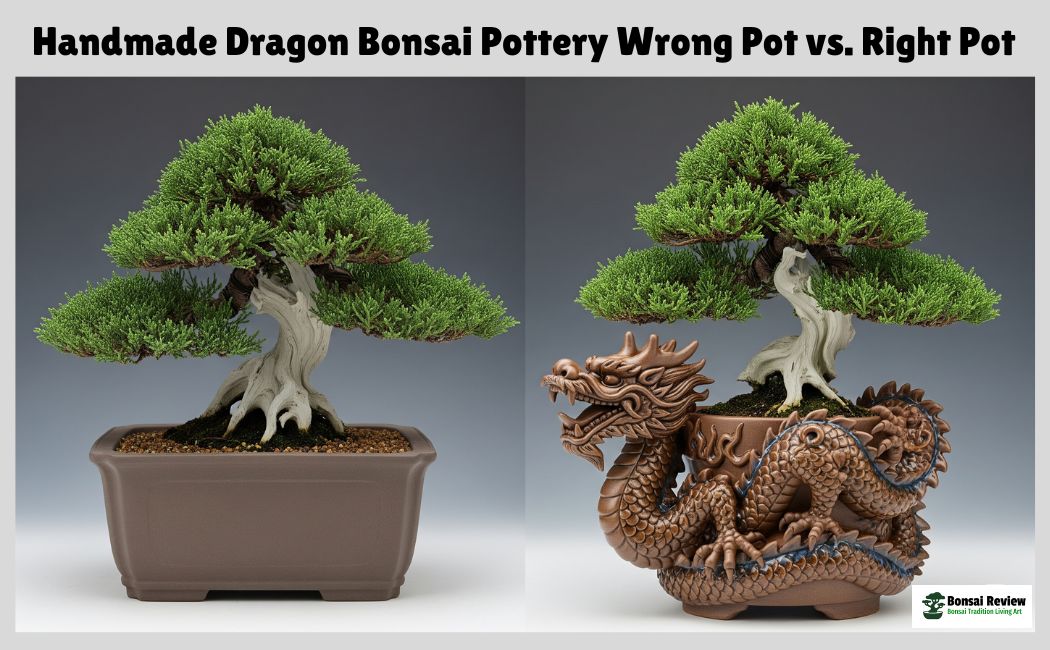
What is the Symbolism of a Japanese Dragon?
In Japanese culture, dragons are powerful and benevolent symbols that represent strength, wisdom, good fortune, and protection. They are often associated with water, rain, and storms, bringing prosperity and balance.
Unlike their Western counterparts, Japanese dragons are not typically depicted as fearsome or destructive. They are seen as guardians of treasures and temples, embodying a deep connection with the divine. Here’s a more detailed look at the symbolism of handmade dragon bonsai pottery:
- Strength and Power: The Dragons are seen as potent creatures, embodying physical and spiritual strength.
- Wisdom and Intelligence: Dragons are considered wise and intelligent beings, often associated with knowledge and understanding.
- Good Fortune and Prosperity: Most bonsai lovers are believed to bring good luck and prosperity, especially in agricultural contexts where they are associated with rain and bountiful harvests.
- Protection: Dragons are seen as protectors, warding off evil spirits and negative influences.
- Water and Rain: Their water connection is a central aspect of their symbolism, representing both the destructive force of storms and the life-giving force of rain.
- Guardianship: Dragons are guardians of temples, treasures, and important places.
- Connection to the Divine: Dragons are often seen as beings with a close connection to the spiritual realm and the divine.
- Imperial Power: In some contexts, particularly in the past, dragons have been linked with imperial authority and power.
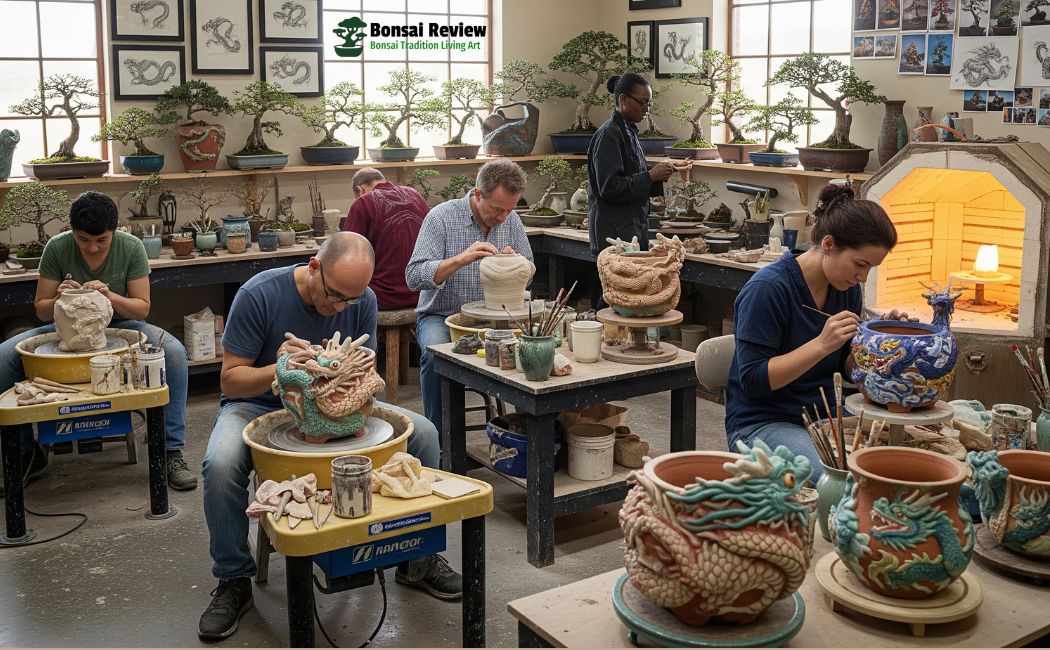
Handmade Dragon Bonsai Pottery: The Perfect Blend of Art, Symbolism, and Function.
The word “Bon-sai”, often misspelled as bonzai or banzai, is a Japanese term which, literally translated, means “planted in a container”. This art form is derived from an ancient Chinese horticultural practice, part of which was then redeveloped under the influence of Japanese Zen Buddhism. Here’s a more detailed breakdown of handmade dragon bonsai pottery symbolized:
1. Power and Wisdom: Handmade Dragon Bonsai Pottery.
Dragons are seen as powerful and wise beings, often associated with the ability to bring order out of chaos and with the role of protectors. In the context of bonsai, the dragon imagery suggests the bonsai tree embodies strength and wisdom, reflecting the perceived age and resilience of the tree.
2. Longevity and Connection to Nature: Handmade Dragon Bonsai Pottery.
Dragons are also symbols of longevity, and bonsai trees are meant to represent ancient trees in miniature. The dragon imagery on the pot can further emphasize the bonsai’s connection to nature’s enduring power and long lifespan.
3. Spiritual Dimension:
The dragon’s presence in bonsai pottery can add a spiritual dimension, connecting the bonsai to mythology and emphasizing its significance as a source of strength and inspiration. Some pots even feature dragons reminiscent of those found at temple entrances, further highlighting the spiritual connection.
4. Good Fortune and Prosperity:
In some traditions, dragons are also associated with good fortune and wealth, bringing happiness and courage. This symbolism can make dragon bonsai pots a meaningful gift, conveying wishes for prosperity and success.
5. Protective Symbol: Handmade Dragon Bonsai Pottery.
Dragons are often seen as protectors, and the imagery can evoke a sense of guardianship, especially when the dragon is depicted with a protective stance or gesture.
In essence, dragon bonsai pottery is a powerful combination of artistic expression and symbolic meaning, bringing together the mystique of the dragon with the enduring beauty and symbolism of the bonsai tree.
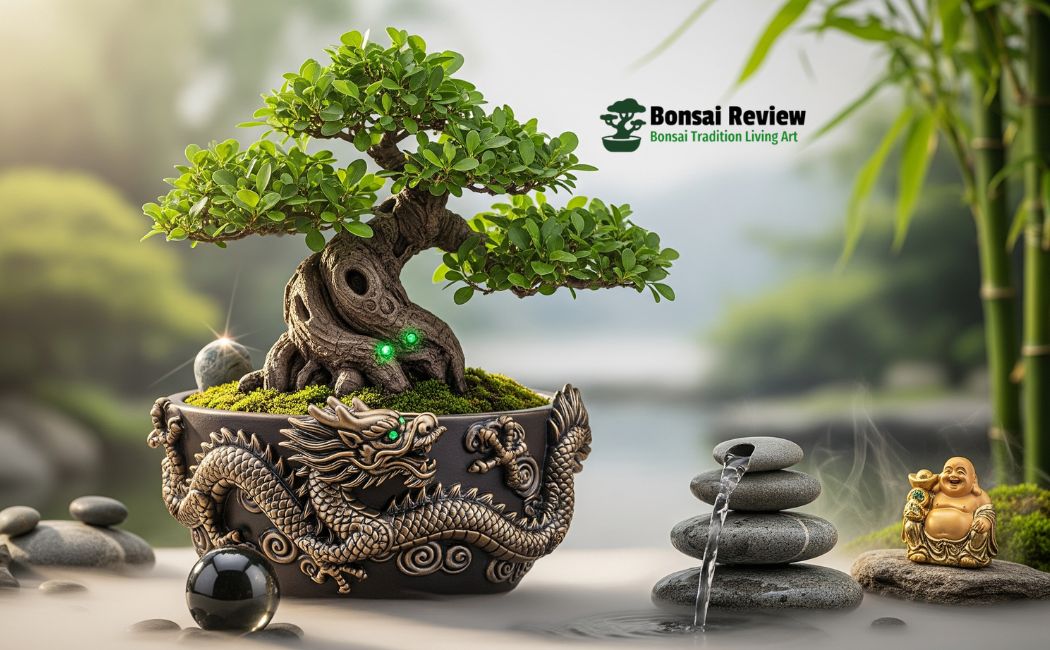
Why Your Bonsai Deserves a Handmade Dragon Pot?
Your bonsai is not just a plant. It is a living art. And every piece of art needs the right frame. For bonsai, that frame is the pot. A handmade dragon bonsai pot is more than a container. Elaboration:
- Size: The pot’s depth should generally match the trunk’s diameter at the base. For rectangular or oval pots, the length should be around two-thirds the height of the tree. If the tree is wider than it is tall, the pot’s length should be two-thirds the tree’s width.
- Shape: The shape of the pot should harmonize with the tree’s style. Formal upright trees often look good in rectangular pots, while informal or flowing styles may be better suited to ovals or rounds. Square pots are often used for sturdy, powerful trees.
- Color: Unglazed, earth-toned pots are traditionally used for evergreen trees like pines and junipers. Glazed pots in earth tones are common for deciduous trees, while flowering or fruiting trees may be placed in colorful, glazed pots.
- Drainage: Bonsai pots should have drainage holes to allow excess water to escape. They should also be slightly raised or have feet to promote air circulation around the base of the pot.
- Material: Common pot materials include ceramic, porcelain, and plastic (for training).
- Root Space: While the pot’s size should be appropriate for the tree’s size, it’s important to remember that bonsai require regular root pruning to maintain their health and size.
The dragon design can be carved, painted, or sculpted, each telling a story of power, good fortune, and protection.
But here is the problem. Many bonsai owners use pots that are too small, too big, or made from poor-quality clay. These cracks in frost soak up water and stress the tree’s roots.
Worse, mass-produced pots often have no style connection to the bonsai itself. The result? The beauty of the tree feels lost.
The solution is to choose a pot that works with your bonsai, not against it. That means finding the right shape, round, oval, rectangle, or cascade, to balance the tree’s height, trunk width, and canopy spread.
How Do I Choose the Right Handmade Dragon Bonsai Pot for My Tree?
When you choose the right handmade dragon bonsai pot, you are not just buying a container. You are giving your bonsai a home that matches its spirit, honors its roots, and turns it into a true showpiece.
The Problem: When the Bonsai Pot Doesn’t Match the Tree?
A bonsai is a balance of nature and design. If the pot is wrong, that balance is broken. Many bonsai lovers make one of three common mistakes:
1. Wrong Size: A pot that is too deep or too wide can hide the tree’s beauty. A pot that is too small can squeeze the roots and slow growth. For example, a cascade-style bonsai needs a tall pot for visual balance, while a formal upright style works best in a shallow oval or rectangle.
2. Poor Materials: Low-fired clay or cheap ceramic cracks in frost and soaks in water. This can lead to root rot, salt build-up, and even breakage during winter. A high-quality stoneware or Tokoname clay pot is fired at high temperatures, making it durable, frost-proof, and non-porous.
3. No Aesthetic Harmony: In bonsai aesthetics, the pot should match the “masculinity” or “femininity” of the tree. A powerful pine with rugged bark might look weak in a delicate glazed pot. A gentle flowering cherry can be overpowered by a heavy, dark, unglazed design. The wrong match makes the bonsai feel incomplete.
The problem is that Handmade Dragon Bonsai Pottery.
Mass-produced pots often have generic shapes, dull glazes, or no dragon motif at all. Without a design that reflects power, good fortune, and protection, the pot misses a chance to add cultural meaning to the display.
Blue handmade dragon bonsai pottery is a colour that naturally complements the earthy tones of the bonsai soil and the greens and browns of the tree. This harmonious colour pairing creates a pleasing and balanced appearance.
This is why serious bonsai growers turn to handmade pottery crafted with the right clay, the right firing method, and the right design for their tree. Only then can the bonsai and pot work together as one piece of art.
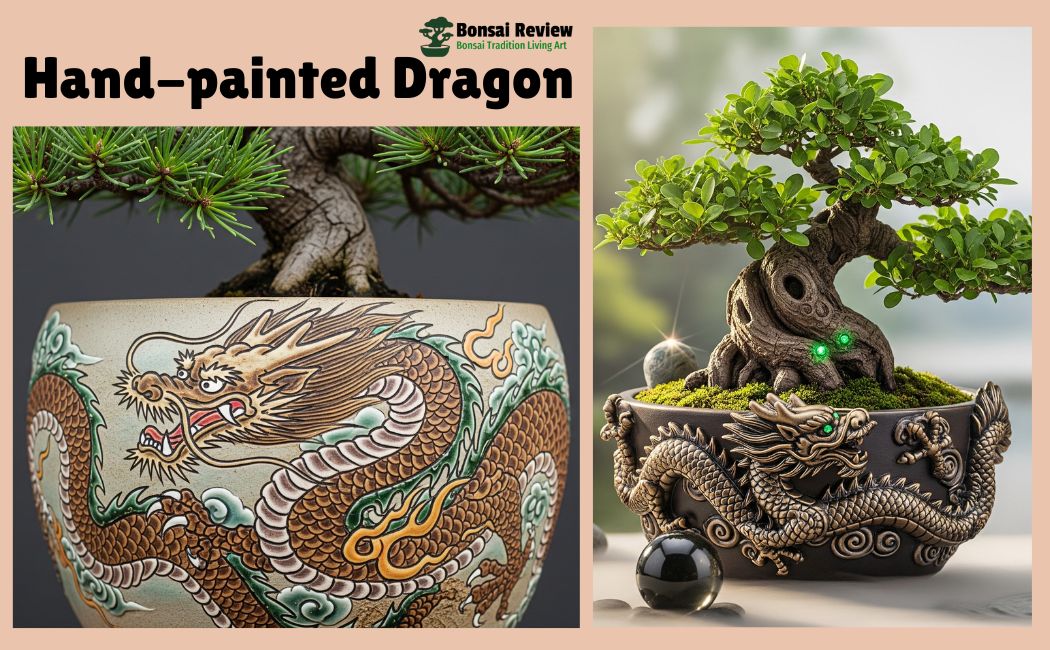
Handmade Dragon Bonsai Pottery: Where Art Meets Living Nature?
The cultural and aesthetic significance of dragons in bonsai pottery. In homemade bonsai culture, every detail matters, even the artwork on the pot.
The dragon motif isn’t just decoration, and it’s a symbol that connects your bonsai to centuries of tradition. In East Asian art, dragons represent power, wisdom, good fortune, and protection.
Japanese bonsai aesthetics in a pot with a dragon design is believed to guard the tree and its owner, while attracting positive energy.
The Chinese symbolism in the dragon is also linked with rain and water, hinting at life, growth, and harmony qualities that every bonsai grower treasures.
How is the dragon shown? Can it change the feeling of the pot?
It is high-fired stoneware or Tokoname clay, shaped by hand, and strong enough to last for decades. It has drainage holes, feet for air flow, and a finish glazed or unglazed that matches your tree’s style.
- Carved in relief: Creates depth and texture, perfect for bold trees like black pine or yamadori junipers.
- Hand-painted detail: Adds elegance, suited for refined bonsai like flowering ume or azalea.
- Sculpted form: Turns the pot into a miniature sculpture, ideal for exhibition-level bonsai.
Even the pot’s glaze color plays a role. A deep red or earthy brown glaze highlights the dragon’s strength, while a soft blue or celadon glaze gives a more peaceful, balanced tone. Unglazed pots often feel more masculine and raw, making them a strong match for rugged tree styles.
When the symbolism of the dragon blends with the shape (round, oval, rectangle, cascade) and style of the bonsai, the result is more than a plant in a container, and it becomes a living artwork that tells a story.
It means matching the pot’s color to the bark or leaves for perfect harmony. And it means picking authentic handmade pottery from skilled makers, whether Japanese masters in Tokoname or American small-batch artisans like Blue Nose Trading or Bonsai Outlet.
Prices can range from simple handmade clay dragon pots under $80 to collectible art pieces worth $300 (apporx) or more.

Which Are The Right-Handed Dragon Bonsai pots for Indoor & Outdoor Spaces?
Where to buy authentic handmade dragon bonsai pottery, local & online. In the United States, you can find collectible pots from specialty shops such as Blue Nose Trading, which often carry both domestic and imported Yixing clay pieces prized for their durability and deep, rich finish.
| Factor | Why It Matters | Best Options for Handmade Dragon Pots | Example Sources |
| Size | Fits root ball, keeps visual balance | Depth matches root spread, width ⅔ of tree height | Blue Nose Trading, Yixing Pot |
| Shape | Matches bonsai style and flow | Oval for informal upright, round for literati, deep round for cascade | Bonsai Fandom, Wikipedia Bonsai Styles |
| Material | Durability, frost resistance | High-fired stoneware, Tokoname clay, Yixing clay | North American & Caribbean Potters list |
| Design & Motif | Adds symbolism and character | Carved dragon relief, hand-painted dragon, sculpted dragon handles | Dragon Bonsai Studio CA, Yixing Pot |
| Glaze & Color | Complements the tree bark and foliage | Earthy brown for rugged pines, celadon for flowering bonsai | Bonsai Aesthetics guides |
| Drainage | Prevents root rot | Multiple large holes with mesh | Bonsaihaat, artisan handmade pots |
| Origin & Craftsmanship | Cultural authenticity & artistry | Japanese Tokoname, Chinese Yixing, and Canadian artisan-made | Dragon Bonsai Studio, local potters |
| Price & Availability | Fits budget and sourcing needs | $40–$300+ depending on size, detail, and rarity | Blue Nose Trading, Etsy, custom orders |
Pro tip: A pot is an investment in your bonsai’s health and beauty. Spending more for handmade, high-fired, artisan-crafted pottery ensures you get a piece that will last decades without cracks, chips, or fading design.
Where Can I Buy Handmade Dragon Bonsai Pots Near Me?
When you’re ready to invest in a handmade dragon bonsai pot, the right source matters just as much as the design. If you’re in Canada, artisan studios like Dragon Bonsai Studio craft unique dragon-themed pottery that blends traditional East Asian motifs with modern glazing techniques.
For collectors who value cultural authenticity, Tokoname and Yixing pots remain the gold standard, with many being available through certified importers or directly from artisan websites.
If you’re shopping online, platforms like Etsy and bonsai-specific marketplaces list handmade unique bonsai pots USA in various price ranges, from budget-friendly options under $50 to high-end collector’s pieces over $300.
Wholesale buyers such as nurseries or bonsai clubs can source bonsai pots wholesale from bulk suppliers, but should always confirm the clay type and firing quality.
For those who prefer seeing the craftsmanship in person, searching “handmade dragon bonsai pottery near me” can lead you to local pottery fairs, bonsai exhibitions, or even private kiln tours where you can meet the potters directly.
If you buy locally or online, always check for drainage holes, clay quality, and authenticity of the artwork. A true handmade dragon pot isn’t just a container, and it’s a signature piece that elevates your bonsai and reflects your personal style.

How Do I Care for a Handmade Dragon Clay Bonsai Pot?
A handmade dragon bonsai pot is more than just a vessel, and it’s an artwork that deserves careful upkeep. Proper care will preserve its hand-painted dragon designs, prevent cracks, and keep the clay strong for decades.
1. Cleaning After Repotting: Care for your handmade dragon bonsai pot.
When you repot your bonsai, rinse the pot gently with lukewarm water. Use a soft brush to remove soil from the carved dragon details. Avoid harsh chemicals they can strip away glazes or fade pottery dragon artwork.
2. Seasonal Protection: Caring for your handmade dragon bonsai pot.
In winter, even high-fired Yixing clay or Tokoname pottery can crack if water freezes in the pot. If your region has frost, store the pot in a sheltered area or use frost-proof mats under the base. Canadian and northern US collectors often move pots indoors during extreme cold.
3. Preventing Glaze Wear:
For glazed handmade pottery, never scrub with steel wool. Instead, use a soft sponge and mild soap. This keeps the earthy browns, celadon greens, or cobalt blues bright for years.
4. Checking Drainage Holes When Buying Handmade Dragon Bonsai Pottery.
Clogged holes can cause root rot. Every few months, check that the mesh covering the drainage holes is intact and not blocked by compacted soil or algae.
5. Display and Handling For Handmade Dragon Bonsai Pottery.
When displaying your bonsai indoors, keep the pot out of direct, harsh sunlight to avoid fading on painted designs.
Always lift from the base, not the rim, especially with older handmade clay dragon pots, as the rim can be the most fragile point.
A little extra care keeps your handmade unique bonsai pot as stunning as the day you bought it. Whether it’s a rustic brown dragon pot from Bonsaihaat or a collectible Canadian artisan-made piece.
Symbolism and Meaning Behind Dragon Bonsai Pottery
In bonsai culture, a handmade dragon bonsai pot is more than a decorative container, and it’s a vessel of meaning. The dragon has deep roots in East Asian symbolism, often representing strength, wisdom, prosperity, and protection. In Chinese tradition, dragons are also guardians of water and life, making them a powerful companion symbol for a living bonsai tree.
When crafted in Yixing clay or Tokoname pottery, the dragon’s meaning is elevated these materials are considered pure and enduring, symbolizing stability and grounding energy. In Feng Shui, placing a bonsai in a pottery dragon pot can invite positive “chi” into your home, especially if positioned in the wealth or career corner.
Collectors in Canada and the USA often seek handmade unique bonsai pots with dragon motifs not only for their artistic beauty but also for their spiritual resonance. A dragon carved around the pot can “circle” the bonsai’s roots, symbolizing protection of growth and balance between heaven and earth.
The combination of a living bonsai and a hand-painted clay dragon merges nature’s vitality with mythical power. Whether displayed in a private collection or gifted, a handmade clay dragon bonsai pot becomes a statement piece that carries both artistry and meaning.
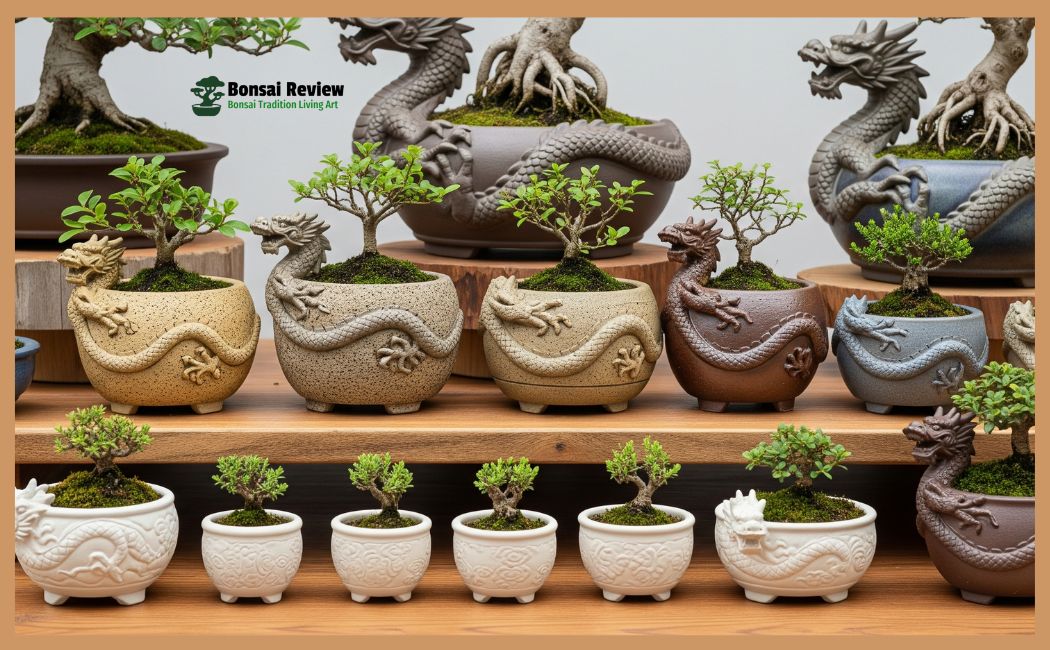
Choosing the Right Bonsai Tree for a Dragon Pot.
A handmade dragon bonsai pot deserves a bonsai that complements its bold design and symbolism. Certain tree types naturally match the strength and presence of a dragon motif.
1. Juniper Bonsai: Known for its rugged bark and twisting branches, the juniper bonsai pairs beautifully with carved or sculpted dragon pots. Its masculine energy resonates with the power and protection represented by the dragon.
2. Chinese Elm Bonsai: With delicate leaves and flexible branches, the Chinese elm bonsai works well in hand-painted dragon pots, where the fine details of the dragon motif enhance the tree’s elegance.
3. Pine Bonsai: Tall, upright pines suit deep, unglazed dragon pots. Their strong silhouette harmonizes with the pot’s commanding presence, creating a balanced, masculine aesthetic.
4. Flowering Bonsai (Azalea, Cherry, Ume): Soft, colorful blooms look stunning in celadon or lightly glazed dragon pottery, where the gentle tones of the pot complement the flowers while maintaining symbolic meaning.
When selecting your bonsai, consider the size and shape of the dragon pot. A small 4–5 inch pot works best with mame bonsai or petite trees, while a larger 10–14 inch dragon pot accommodates medium to large bonsai. Always ensure the pot enhances the tree’s style, not overpowers it, to maintain bonsai harmony and aesthetic balance.
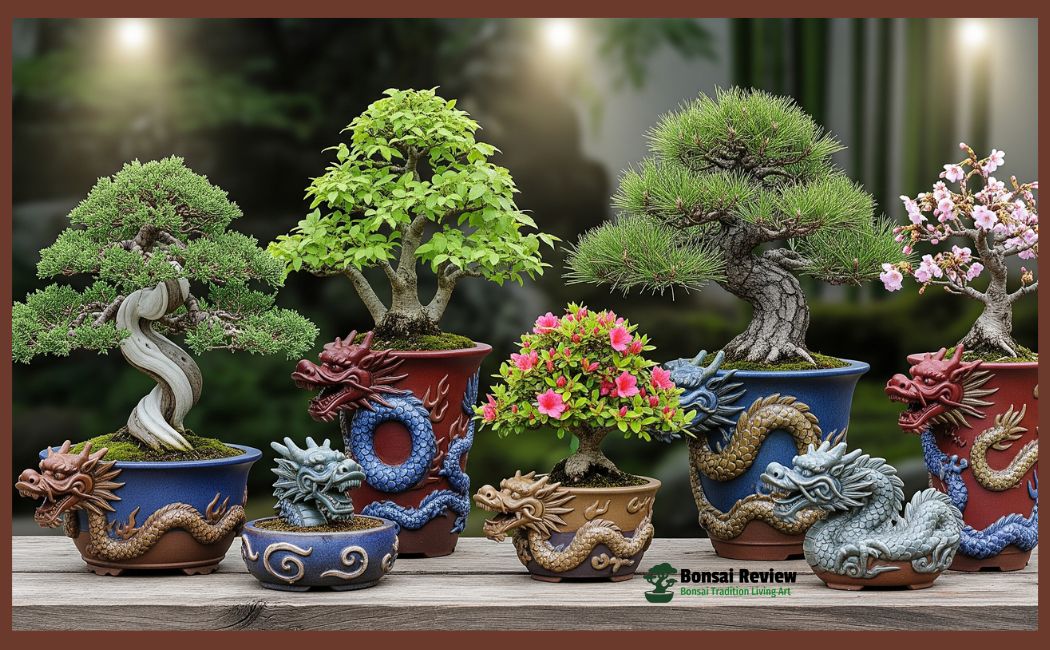
How Much Should I Pay for a Handmade Dragon Bonsai Pot?
Pricing and value of handmade dragon bonsai pots. The cost of a handmade dragon bonsai pot varies widely depending on size, material, design, and the artisan behind it.
Small mame bonsai pots with simple carved dragons can start as low as $40–$50. Medium-sized pots, often high-fired stoneware or Tokoname clay with detailed dragon reliefs or hand-painted motifs, typically range from $100–$250 (Approx). Collector-level or exhibition pieces, such as sculpted or fully hand-painted dragon pots from renowned artisans, can exceed $300–$400.
Factors that affect price include:
- Material quality: High-fired stoneware and authentic Tokoname or Yixing clay command higher prices.
- Craftsmanship: Hand-thrown, hand-painted, or sculpted designs increase value.
- Size and depth: Larger pots require more clay and labor.
- Rarity and uniqueness: Limited editions or signature pieces are priced higher.
For those on a budget, online marketplaces like Etsy and bonsai specialty stores offer affordable handmade clay dragon pots. Wholesale buyers, such as bonsai clubs or nurseries, can find handmade, unique bonsai pots in the USA through trusted sellers like Blue Nose Trading or local artisan networks.
Investing in a quality handmade dragon bonsai pot is more than a purchase, and it’s acquiring a piece of living art that elevates your bonsai’s display, preserves its health, and retains value over time.
Conclusion: Elevate Your Bonsai with a Handmade Dragon Pot
A handmade dragon bonsai pot is more than just a container. It combines artistry, craftsmanship, and symbolism to create a home that enhances your bonsai’s beauty and vitality. By choosing the right clay material, whether high-fired stoneware, Tokoname, or Yixing clay, and selecting a dragon motif that matches your tree’s style, you ensure both aesthetic balance and cultural meaning.
From junipers and pines to delicate flowering bonsai, pairing the right tree with a dragon pot highlights its natural form while reflecting the power, protection, and good fortune dragons symbolize. Proper care, attention to size, shape, drainage, and glaze, and sourcing from trusted artisans or specialty stores guarantee that your bonsai pot remains a lasting centerpiece.
Ultimately, a handmade dragon bonsai pot turns a simple bonsai display into living art, a harmonious blend of nature, craftsmanship, and cultural richness that you can enjoy for years to come.
Helpful article: What Is the Best Traditional Pot for Bonsai Trees in the USA?
FAQs About Handmade Dragon Bonsai Pottery.
1. Is a dragon a good symbol?
In Chinese spirituality means dragons symbolize power, good fortune, and prosperity. They are considered auspicious creatures, often linked to the emperor and seen as a symbol of divine protection and strength. The Chinese dragon is also associated with water elements, such as rivers and rain.
2. What is a handmade dragon bonsai pot?
A handmade dragon bonsai pot is a pottery container created by skilled artisans, often from high-fired stoneware, Tokoname clay, or Yixing clay. It features dragon motifs that can be carved, painted, or sculpted, combining functional design with artistic and symbolic value.
3. Why choose a dragon design for my bonsai pot?
Dragons symbolize power, protection, wisdom, and good fortune in East Asian art and Feng Shui. Using a dragon motif enhances the aesthetic appeal of your bonsai while adding a spiritual and cultural element.
4. Can any bonsai tree go in a dragon pot?
Not every bonsai fits perfectly. Trees like juniper, pine, Chinese elm, azalea, and cherry bonsai pair beautifully with dragon pots. Consider pot size, shape, and tree style for balance and harmony.
5. Where can I buy handmade dragon bonsai pottery?
You can find authentic pieces at artisan studios like Dragon Bonsai Studio (CA), specialty retailers such as Blue Nose Trading or Bonsai Outlet, or online marketplaces like Etsy. Searching for “handmade dragon bonsai pottery near me” can also locate local artisans and fairs.
6. How much does a handmade dragon bonsai pot cost?
Prices range widely. Small mame bonsai pots start around $40–$50, medium-sized stoneware or Tokoname dragon pots cost $100–$250, and rare collector pieces with hand-painted or sculpted dragons can exceed $300 (Approx).
7. How do I care for a handmade dragon bonsai pot?
Clean gently with lukewarm water and a soft brush. Avoid harsh chemicals to protect the glaze and painted designs. Check drainage holes regularly to prevent root rot. Protect from frost if your region is cold.
8. Are there wholesale options for handmade dragon bonsai pots?
Yes. Bonsai clubs, nurseries, and collectors can source online handmade unique bonsai pots USA wholesale from trusted suppliers or artisan networks. Always confirm clay quality, firing method, and design authenticity.
9. What is the famous dragon symbol?
The dragon was the symbol of the Chinese emperor for many dynasties. During the Qing dynasty, the Azure Dragon was featured on the first Chinese national flag. It was featured again on the Twelve Symbols national emblem, which was used during the Republic of China, from 1913 to 1928.
10. What does a green dragon symbolize in Japan?
The Green Dragon represents Wood, which signifies growth, renewal, and vitality. This combination of the Dragon and the Wood elements is potent, as it is believed to bring a strong force of positive energy. Wood is associated with expansion and development, while the Dragon symbolises strength and good fortune.